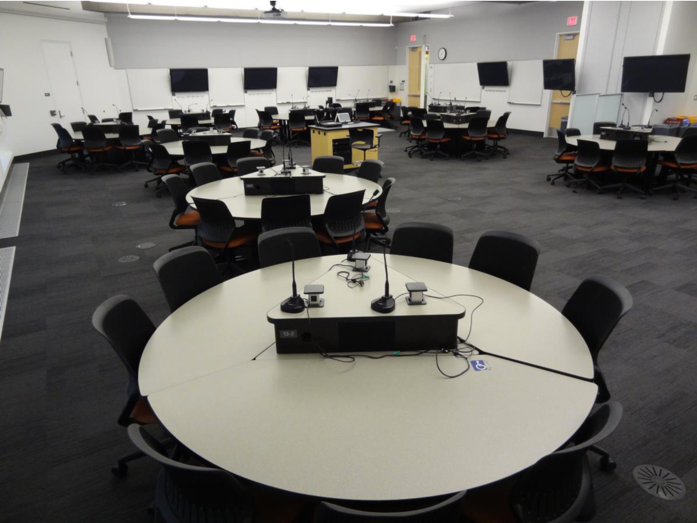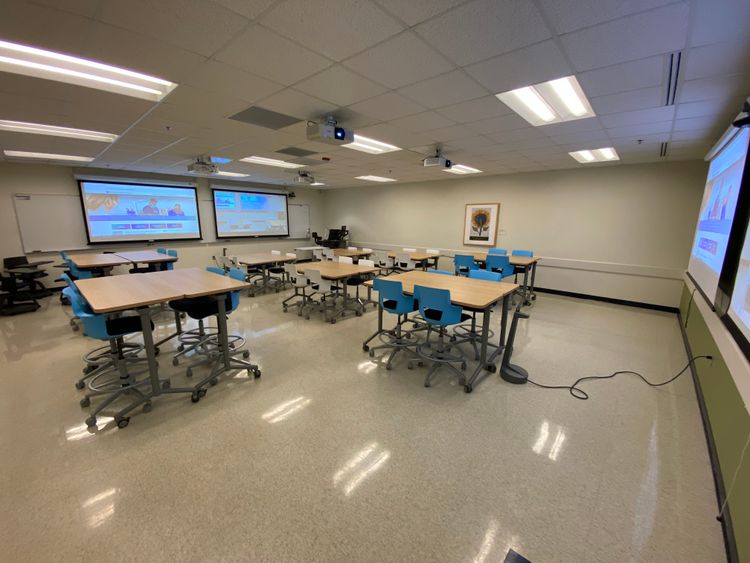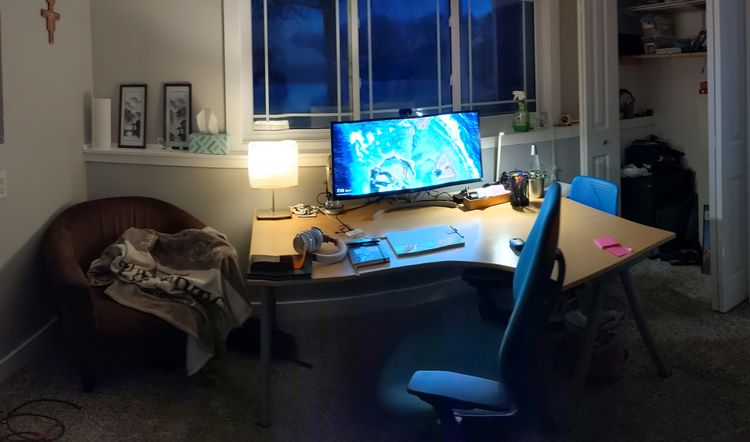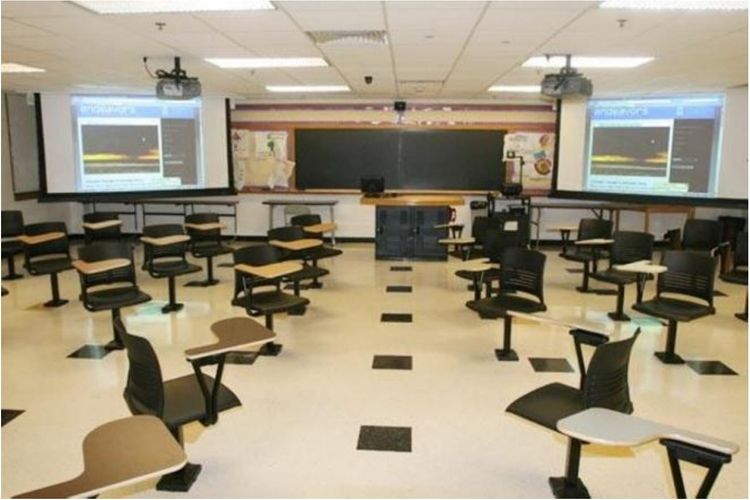How can a big lecture class become small and active?

As I continue to read the research on active learning classrooms as well as observe how these classrooms are used by real teachers, I'm impressed with the range and ingenuity of the uses of these spaces. This week in the 1000-word literature review series, I wanted to highlight a paper I read that I kept thinking about long after the reading was over, because it is on the upper end of the ingenuity scale. That paper is:
Baepler, P., Walker, J. D., & Driessen, M. (2014). It’s not about seat time: Blending, flipping, and efficiency in active learning classrooms. Computers and Education, 78, 227–236. http://doi.org/10.1016/j.compedu.2014.06.006
What questions does this paper try to answer?
Many college faculty who teach large classes like the idea of active learning but don't think it would work for them, partly because the size of the class and partly because of the space. If you have a large class, you are probably going to be in a lecture hall, and that's not conducive for active learning. Specialized active learning classrooms, like the ones I see at Steelcase, tend to be designed for around 30 students. Even the biggest ones tend to max out around 120 students. If you have a class of 350, it would seem like you're out of luck.
This was the issue that the researchers in this study were up against with their 350-student introductory General Chemistry class. The course met three days per week and was taught using 100% lecture. The researchers wanted to reorganize the class around active learning, but both size and the room were getting in the way. So they took an unusual approach that involved some highly creative scheduling.
The 350 students in the class were put into three groups of around 115 students each. Instead of having the whole class meet three days a week, each group of 115 only met once per week --- the first group on Monday, the second on Wednesday, the third on Friday. If you're keeping score, that means a 66% reduction in the amount of classes each student attends. The one class meeting per week each student does attend was redesigned to be focused on active learning tasks: problem solving challenges, clicker questions, games --- but never lectures. Because there were "only" 115 students meeting at any given time, they could meet in this active learning classroom, inspired by the SCALE-UP and TEAL rooms:

The room contained 13 round tables with nine students each for a total capacity of 117 students. The low-level learning tasks that would ordinarily take place in class now took place before the weekly class meeting, through recorded lectures, discussion boards, and so on. In other words, the course was converted into a hybrid course, using a flipped learning methodology.
You'd be well within your rights to wonder if such an approach could possibly help students learn chemistry better. That's the main research question of the study: Can student in-class time and student-faculty face-to-face contact time be reduced by 66% without undermining the student learning experience or student learning outcomes, by moving the course from a traditional format to a flipped hybrid format based in an active learning classroom?
What were the methods?
The flipped hybrid sections were run twice in different semesters. In the traditional section and in both flipped hybrid sections, the researchers administered collected data on course grades, demographic data, and qualitative data on student perceptions of the course via a survey on the last day of class. There were also two exams administered during the semester: A 20-item multiple choice chemistry exam developed by the American Chemical Society (ACS), and a separate 40-item exam created by the instructors.
What did it find out?
The results of the study show:
- There was a moderate but significant difference in performance on the ACS exam between the traditional section and the first flipped hybrid section, with the flipped hybrid section performing better. The difference between the traditional section and the second flipped hybrid section was not statistically significant.
- On the survey of student perceptions, the students in the first flipped hybrid sections gave significantly higher scores on questions pertaining to engagement, enrichment, student learning outcomes, confidence, and other qualitative variables. The second round of the flipped hybrid class showed similar results although a few of the variables no longer had significant differences.
These results occurred even after controlling for all the possible effects of demographics and prior preparation for the course.
In other words, students in the flipped hybrid course did at least as well and in many cases better in terms of learning outcomes than their counterparts in a traditional lecture course, despite the massive reduction in face-to-face class time. Those students also rated the experience of the flipped hybrid model significantly higher than the traditional lecture course.
What does this mean for teachers and other ordinary people?
What this study shows (and there are others like it) is that pedagogy trumps class size. A large class that uses active learning methods skillfully, will get better results from students than a small class taught using only lecture. Merely reducing class sizes isn't enough. There's a natural tendency to say that smaller classes are better for learning than larger classes, but the reality is more nuanced. We should be striving to use active learning in all classes, especially the large ones.
Which leads to another important point underscored by this paper: It is definitely possible to use active learning in significant ways in a large class. Just because you have 50, 100, or 350 students in a class does not mean you are forced to only lecture. Maybe turning that class into a flipped hybrid class isn't realistic; but look for small teaching methods like the humble think-pair-share activity that cost nothing and scale up infinitely, or check out technology-enabled methods like peer instruction that were specifically invented for large classes.
What are the strengths and weaknesses?
As usual, I've summarized rather than detailed all the methodology and statistical analysis in this paper, but I assure you that this was one of the more rigorous studies I've seen lately. Even so, there are some issues. One of the weaknesses of the study is that it's a post-test only design, i.e. lacking a pre-test that can be used to show the gains students made over the course of the semester. It would have been interesting, and the results a little stronger, to see not only how well students did on the ACS exam but how much better they did from the first to the last weeks. Also, the data on the outcomes of the other exam used in the class (40 items designed by instructors) is curiously missing from the results. Maybe I missed it -- but what did those data say?


